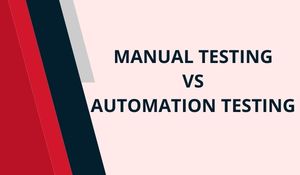
Software testing for any growing software project is an integral part of the development. It itself is a huge domain, but it can be broadly categorized into two areas that are manual testing and automation testing. Software testing is a process to measure its software application’s functionality with the purpose of finding to meet the specific requirements of the developed software to identify the bug defects and ensure that the product is bug-free in order to build a quality product. This type of testing is manual or automated depending on various factors, which include project requirements, budget, timeline, expertise, and suitability. Three main factors of any project are time, cost, and quality where the goal of any upcoming successful project is to reduce the cost and time consumed to complete it successfully while maintaining quality outcomes. Both manual testing and automation testing have their own advantages and disadvantages but it’s worth knowing the benefits of each approach and will try to conclude the best option for each use case. Further, take a look at the difference between manual testing and automated testing.

Defining Manual Testing
Manual testing is testing of the software where tests are executed manually one at a time by a QA Analyst. The purpose of manual testing is to discover bugs and feature the issues before a software application goes live. The skills, knowledge, and experience of the testers play a vital role in Manual Testing. In this testing, we do not take any help from automation tools to perform the testing. In manual testing, the tester validates all the necessary key features of the given software application. In this process, to generate the test reports software testers carry out the test cases without any assistance from automation testing tools which results in finding bugs in software systems. Therefore this is a classical method of all the other testing types, normally conducted by an experienced tester to bring about the software testing process.
Automation Testing in Brief
Automation testing is a process of changing any manual test case into the test scripts and testing the software by using automation testing tools. Testers write the code and test scripts to automate test execution. Testers use suitable automation tools to develop the test scripts and validate the software applications and find the defects. The goal is to complete test execution in less amount of time. Automation testing is used to increase the productivity, effectiveness, and coverage of Software testing. Automation test engineers automate the manual design test cases without any human interference using these automation testing tools. And these testing tools can control the execution of tests, access the test data, and compare the actual result against the expected result. Without the intervention of manual testers, automated testing will allow you to execute repetitive tasks and regression tests.
A list of popular automation testing tools are:
- HP Quick Test Professional or UFT (Unified Functional Testing)
- Selenium
- LoadRunner
- TestComplete
- IBM Rational Functional Tester
- WinRunner
- SilkTest
- WATIR
Comparisons between Manual Testing and Automation Testing
1. Definition of each: Manual testing test cases are executed by a human tester to check the functionality of an application based on the customer requirement. Automation Testing is done by using automation tools to execute test cases. Whenever multiple releases are done on the software application, we will go for automation testing.
2. Reliability: Manual testing is not accurate, it is not reliable because there is a possibility of human error, which may not be delivered to the defect-free application. In automation, it is reliable because with the help of tools and test scripts it tests the applications.
3. Initial investment and Cost-effective: The initial investment and ROI in manual testing are low when compared to Automation testing and it is not cost-effective for high volume regression. In automation testing initial investment is high. Although the ROI is better in the long run and not cost-effective for low volume regression.
4. Regression testing: It may be useful when the test engineer executes the test case for the first time, because of changing requirements frequently there is a possibility that it will not catch the regression bugs. Whenever the code changes happen due to the enhancement of the release, the automation test engineer performs the regression testing.
5. Performance Testing: Performance Testing is not feasible manually. Compulsorily Performance Tests like Load Testing, Stress Testing, Spike Testing, etc. have to be tested by an automation tool.
6. UI Change: Small changes like a change in id, and a class of a button would not counter the execution of a manual tester. Automated Test Scripts need to be modified to work as expected even for an insignificant change in the UI of the AUT.
7. Framework: While using manual testing there is no need for a framework. To speed up the automation process, the automation test engineer can use the different types of frameworks like Data-driven, modular-driven, Hybrid, and keyword-driven.
8. Programming knowledge: No need for programming in Manual Testing. Programming knowledge is a must in automation testing.
9. Operating system compatibility: Operating system compatibility is not possible in manual testing because a different tester is required to perform such tasks. Automation testing can also be performed on various programming languages and different systems with different operating system platforms.
10. When to Use? : Manual Testing is user-friendliness and is suitable for Exploratory, Usability, and Adhoc Testing. Regularly it should also be used where the AUT changes . Automated Testing cannot guarantee user-friendliness and is suited for Regression Testing, Performance Testing, Load Testing, and functional test cases.
11. Batch Execution: Batch execution is not possible in manual testing. It is possible using automation testing because all the written scripts can be executed collaterally.
12. Time-saving: In manual testing, it takes more time due to the usage of human resources. The execution is always faster than processing in manual, hence the automation testing process is time-saving.
13. Parallel Execution: Manual tests can undergo parallel execution but it is a high price to increase the human resource. Automation testing can reduce test execution time and also it is executed on different operating platforms in parallel.
14. Test Design: Manual Unit Tests do not drive test design into the coding process. Automation Unit Tests enforce Test-Driven to test Development Design.
15. Ideal approach: Manual testing is effective when the test case runs only once or twice. Automation testing is favored when executing the same set of test cases frequently.
When do you prefer Manual Testing over Automation Testing?
These are the following scenarios:
- At the initial stage of a developing project.
- User interfaces were tested in particular with their visual aspects.
- If the duration is less than is in the short term, writing scripts will be too time-consuming when compared to manually done testing.
- When performing exploratory testing or Adhoc testing.
- Take an example of giving “Captcha” if this test case is not automated.
When do you prefer Automation Testing over Manual Testing?
- When there is a situation to handle repetitive and time-consuming tasks.
- Although parallel testing is required.
- To avoid errors made by humans.
- To do non-functional testing like load testing, performance testing, and stress testing.
Conclusion
Software Testing is a huge domain where Manual Testing is thus as far as important as Automation. There are various testing methods but when we need to opt for Manual Testing, Automation tools cannot come help. The tool and tool scripts are designed manually. Tools may not have human intervention but it requires the command which is given by a human. Software applications are only capable of performing what they are asked to do and this is the limitation and also sometimes an advantage as they cannot act smarter than an individual. Automation tools eventually will evolve. The real value of manual testing and automation testing occurs when in the right environment, the right type of testing is enforced. In fact, both Manual Testing and Automation Testing have pros and cons, and choosing between these two depends on the requirements of the project, client, time, and budget. In the end, we can say that when we require skilled testers we can go with manual testing, and where we need to automate the test case, we can choose Automation. Hope you have a sheer idea of the comparisons, up-skill your Professional career with Gologica, Happy Learning!!











